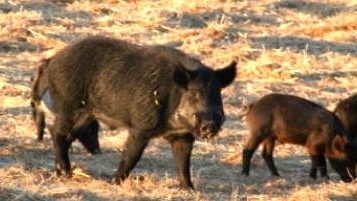NWRC Research Areas: Feral Swine and Ungulate Research

Our scientists are defining economic impacts and developing control strategies for reducing impacts of feral swine and other ungulates.
Feral swine have been called the “rototillers” of nature. Their long snouts and tusks allow them to rip and root their way across America in search of food. Unfortunately, the path they leave behind impacts ranchers, farmers, land managers, conservationists, and suburbanites alike.
Found in at least 35 States, feral swine cause approximately $2.5 billion in damages and control costs in the United States each year, with at least $800 million of this estimate due to direct damage to agriculture. The damage caused by feral swine seems endless and includes the following:
- Destroying native habitats, crops, lawns, and river banks through rooting and wallowing
- Eating and destroying agricultural crops
- Competing with native wildlife for food and other resources
- Carrying or transmitting over 30 diseases and 37 parasites
- Contaminating human food sources and water supplies
- Destroying property and fences
- Eating ground nesting birds and other small wildlife
- Consuming livestock feed and supplements and fouling water sources
- Colliding with vehicles
The APHIS Wildlife Services (WS) program provides technical advice to landowners, State agencies and others, as well as direct management assistance for feral swine problems in more than 30 States. This is often necessary because hunting alone cannot resolve feral swine conflicts with humans. WS experts provide a 3-pronged approach that involves management, disease surveillance, and research.
WS researchers at the National Wildlife Research Center (NWRC) support this effort by studying a variety of issues such as feral swine behavior and ecology, disease transmission, and the development of new management tools and techniques. Recent efforts have evaluated the effectiveness of an oral toxicant bait and swine-specific bait delivery systems, as well as existing trap designs.
Managing Ungulates
Another primary focus of APHIS is protecting the health of livestock, including captive cervids (e.g., deer and elk), realizing that the health of wild cervids affects that of livestock, and vice versa. The role of NWRC's research in this area is to address scientific questions that will lead to a better understanding of the diseases and to develop means to manage and control them. NWRC scientists are highly qualified to research disease transmission at the interface between wild and domestic ungulates because of their expertise in cervid and disease ecology, biology, and management. Scientists and disease specialists are actively involved in the development of new surveillance systems capable of improving detection of diseases of in wildlife, including development of surveillance tools measuring volatile organic compound biomarkers present in the feces of wildlife infected with bovine tuberculosis (bTB) and chronic wasting disease (CWD). Once more is learned about the ecology of these diseases; the cervids and other species affected; and the transmission, prevalence and persistence of bTB and CWD in wild and captive cervids, the knowledge can be used not only for disease management but also to educate the public about associated transmission risks.
Project Goal and Objectives
Goal: Generate and disseminate applied ecological information related to developing tools to control feral swine damage and wildlife diseases that affect humans and livestock.
Objectives:
- Develop feral swine and other wildlife damage control and mitigation methods.
- Determine factors involved in the transmission of diseases in feral swine to livestock and humans.
- Determine factors impacting feral swine and other wildlife damage to agriculture, natural resources, and property.
- Ungulate movements and disease ecology.
- Disease detection and managing disease transmission at the wildlife-livestock interface.
- Provide service assistance to stakeholders and to other projects
Related links
- Feral Swine and Ungulate Impacts (Peer Reviewed Publications)
- Questions and Answers — Sodium Nitrite Toxic Bait for Feral Swine (3.25 MB) (Factsheet)
- Aging Feral Swine in the Field Tech Note (4.77 MB) (Tech Note)
- Estimating Feral Swine Damage to Row Crops Just After Planting (2.73 MB) (Tech Note)
- Estimating Feral Swine Damage to Low-growing Row Crops at Harvest (2.73 MB) (Tech Note)
- Using GPS Measurements to Estimate Damage (879.34 KB) (Tech Note)
Contact Us
Feral Swine and Ungulates
Kurt VerCauteren, Project Leader
Email: Kurt.C.Vercauteren@usda.gov
Phone: 970-266-6093
4101 Laporte Avenue
Fort Collins, CO 80521

